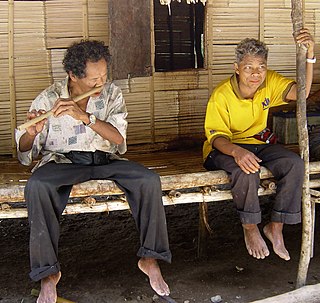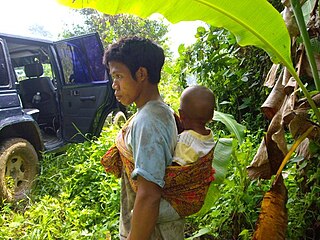Related Research Articles

Kajang is a town in Hulu Langat District, Selangor, Malaysia. Kajang, along with much of Hulu Langat District, is governed by the Kajang Municipal Council. Kajang town is located on the eastern banks of the Langat River. It is surrounded by Cheras, Semenyih, Bangi, Putrajaya and Serdang.

Orang Asli are a heterogeneous indigenous population forming a national minority in Malaysia. They are the oldest inhabitants of Peninsular Malaysia.

Jakun people or Orang Ulu/Orang Hulu are an ethnic group recognised as Orang Asli of the Malay Peninsula in Malaysia.

The Gombak District is an administrative district located in the state of Selangor, Malaysia. The district was created on February 1, 1974, the same day when Kuala Lumpur was declared a Federal Territory. Until 1997, Rawang was the district capital; the capital has been moved to Bandar Baru Selayang. Gombak borders Kuala Lumpur to the southeast and the Genting Highlands to the east. Both Gombak and Kuala Lumpur, along with some other districts in Selangor, are situated within the Klang Valley. Other localities that are situated in Gombak district include Batu Arang, Kuang, Rawang, Kundang, Gombak Town, Selayang, Batu Caves and Hulu Kelang.
Bukit Lanjan is a hill in Petaling District, Selangor, Malaysia. Bukit Lanjan is part of the Damansara parliamentary constituency.
Bandar Muadzam Shah is a township in Rompin District, Pahang, Malaysia. The town was established in 1979 by the South-East Pahang Development Authority (DARA) under the purview of the second Malaysian Prime Minister, Tun Abdul Razak, who also happened to be the native of nearby Royal Town of Pekan.

Aboriginal title is a common law doctrine that the land rights of indigenous peoples to customary tenure persist after the assumption of sovereignty under settler colonialism. The requirements of proof for the recognition of aboriginal title, the content of aboriginal title, the methods of extinguishing aboriginal title, and the availability of compensation in the case of extinguishment vary significantly by jurisdiction. Nearly all jurisdictions are in agreement that aboriginal title is inalienable, and that it may be held either individually or collectively.
Temuan language is a Malayic language spoken by the Temuan people, one of the Orang Asli or indigenous peoples of Peninsular Malaysia which can be found in the states of Selangor, Pahang, Johor, Malacca and Negeri Sembilan. Temuan is a separate language but has a degree of mutual intelligibility with the Malay language. It is written in a Latin alphabet, but no standard orthography has been made.

The Orang Asli Museum is a museum in Gombak, Selangor, Malaysia that showcases the history and tradition of the indigenous Orang Asli people. It includes a library and a small theater hall, and was opened on 29 September 1987 by Prime Minister Mahathir Mohamad.

The Temuan people are a Proto-Malay ethnic group indigenous to western parts of Peninsular Malaysia. They can be found in the states of Selangor, Pahang, Johor, Negeri Sembilan and Malacca. The Temuans are classified as part of Orang Asli group according to the Malaysian government. They are also one of the largest and the most widespread of the Orang Asli ethnic groups.

The Senoi are a group of Malaysian peoples classified among the Orang Asli, the indigenous peoples of Peninsular Malaysia. They are the most numerous of the Orang Asli and widely distributed across the peninsula. The Senois speak various branches of Aslian languages, which in turn form a branch of Austroasiatic languages. Many of them are also bilingual in the national language, the Malaysian language.

The Orang Asal are the indigenous peoples of Malaysia. The term is Malay for "Original People", used to refer to the aboriginals of Sabah, Sarawak, and Peninsular Malaysia. These groups are given the Bumiputera status in Malaysia.
Orang Kanaq are one of the 18 Orang Asli ethnic groups in Malaysia. They are classified under the Proto-Malay people group, which forms the three major people group of the Orang Asli. The Orang Kanaq are considered as the smallest Orang Asli group with the population of approximately 90 people only.
The Department of Orang Asli Development, abbreviated JAKOA, is the Malaysian government agency entrusted to oversee the affairs of the Orang Asli. This body is under the Malaysian Ministry of Rural Development and was first set up in 1954.
Amani Williams-Hunt bin Abdullah, is a notable indigenous Malaysian social activist, and politician who campaigned for most of his life seeking greater social justice, land rights, and improved life opportunities for Aboriginal Malaysians in Peninsular Malaysia. He is fondly known as Bah Tony amongst the Orang Asli communities throughout the country, is very active in Orang Asli advocacy and was President of Persatuan Orang Asli Semenanjung Malaysia from 1987 to 1991.

Orang Seletar are one of the 18 Orang Asli ethnic groups in Malaysia. They are classified under the Proto-Malay people group, which forms the three major people group of the Orang Asli. The Orang Seletar are also considered as part of the Orang Laut, natives of the Straits of Johor; separating Singapore from Peninsula Malaysia.

Ahmad Faizal bin Azumu, nicknamed Peja, is a Malaysian politician who served as the Minister of Youth and Sports in the Barisan Nasional (BN) administration under former Prime Minister Ismail Sabri Yaakob from August 2021 to the collapse of the BN administration in November 2022, Special Advisor to the Prime Minister Muhyiddin Yassin in the Perikatan Nasional (PN) administration for only 11 days in August 2021, 12th and 13th Menteri Besar of Perak from May 2018 to his resignation and collapse of the Pakatan Harapan (PH) state administration in March 2020 and again from March 2020 to his resignation again and the collapse of the PN state administration in December 2020. He also served as the Member of Parliament (MP) for Tambun and Member of the Perak State Legislative Assembly (MLA) for Chenderiang from May 2018 to November 2022. He is a member, Deputy President and State Chairman of Perak as well as Pahang of the Malaysian United Indigenous Party (BERSATU), a component party of the ruling PN coalition at the federal level and former component party of the PH opposition coalition at both the federal and state levels. He was the State Chairman of PH of Perak. He was one of the only two Menteris Besar of Malaysia who has ruled in two state administrations of two different and opposing political coalitions, which were PH state administration from May 2018 to his resignation and its collapse in March 2020 and PN state administration from March 2020 to his resignation and its collapse in December 2020.

Cheq Wong people are an indigenous Orang Asli people of the Senoi branch in Peninsular Malaysia. Although they have the physical appearance of the Senoi sub-group, the Cheq Wong language that they speak is closely related to the Northern Aslian languages.
The Kuala Langat North Forest Reserve (KLNFR) is a 957.6 ha protected peat swamp forest in the Kuala Langat District of Selangor, Malaysia. Some forests within the reserve are 8,000 years old. The reserve is used by some members of the indigenous Temuan people.
Shah Alam Community Forest (SACF) is a recreational site in Section U10, Shah Alam in Selangor, Malaysia. It is adjacent to the Shah Alam National Botanical Gardens. The main trail consists of a 6.9-km loop that is fairly challenging and can take around 3 hours to complete. The trail has an elevation gain of around 600 feet and is rated as "hard".
References
- 1 2 "Orang Asli's Rights: Malaysia's Federal Court faces acid test" (PDF). Asian Indigenous and Tribal Peoples Network. 2006. Archived from the original (PDF) on 2011-12-05. Retrieved 2 Nov 2012.
- 1 2 3 4 5 "Orang Asli get RM6.5m compensation". Free Malaysia Today. 2010. Archived from the original on 2013-01-24. Retrieved 2 Nov 2012.
- 1 2 3 4 "Sagong Tasi & Ors v. Kerajaan Negeri Selangor & Ors 2002 (High Court)". The Malaysian Bar. 2002. Retrieved 2 Nov 2012.
- 1 2 "National Land Code, Act 56, Malaysia". 1965.
{{cite web}}: Missing or empty|url=(help) - ↑ "Land Acquisition Act, Act 486, Malaysia" (PDF). 1960. Archived from the original (PDF) on 2012-01-31. Retrieved 10 Nov 2012.
- ↑ "Aboriginal People's Act, Act 134, Malaysia" (PDF). The Malaysian Bar. 1954. Archived from the original (PDF) on 2013-11-25. Retrieved 10 Nov 2012.
- 1 2 "Selangor to gazette 25 orang asli villages following landmark decision". The Star Online. 2010. Archived from the original on 2012-02-04. Retrieved 2 Nov 2012.
- 1 2 3 4 Nicholas, Colin (2005), Orang Asli Land Rights Upheld, Aliran Monthly, Vol. 25 (8), pp. 37–40, retrieved 2 Nov 2012
- ↑ "Orang Asli at Odds with the Nation-State". Cultural Survival Inc. 9 April 2010. Retrieved 18 Nov 2012.
- 1 2 3 Bunnell, Tim; Nah, Alice M. (2 July 2016). "Counter-global Cases for Place: Contesting Displacement in Globalising Kuala Lumpur Metropolitan Area". Urban Studies. 41 (12): 2447–2467. doi:10.1080/00420980412331297627.
- ↑ Kingsbury, Benedict (1999), "The applicability of the international legal concept of "indigenous peoples" in Asia", in Bauer, J. R. (ed.), The East Asian Challenge for Human Rights, Cambridge: Cambridge University Press, pp. 337–377
- ↑ Nicholas, Colin (1996), "A common struggle: Regaining Control", in Nicholas, C.; Singh, R. (eds.), Indigenous Peoples of Asia: Many Peoples, One Struggle, Bangkok: Asia Indigenous Peoples Pact, pp. 1–10
- ↑ "Selangor vs Sagong Tasi". 19 Sep 2005. Retrieved 2 Nov 2012.
- 1 2 "Better governance pledge under Pakatan 'no fairy tale'". Free Malaysia Today. 8 April 2011. Retrieved 2 Nov 2012.
- ↑ "Sagong Tasi land rights case conclusion – Selangor Pakatan Rakyat Government Statement". 2010. Archived from the original on 2013-03-29. Retrieved 2 Nov 2012.
- ↑ "Corporatising JHEOA: Its impact on indigenous rights". The Nut Graph. 20 Jul 2010. Retrieved 10 Nov 2012.